Storm Agnes: Bomb cyclone hits Ireland, UK with hurricane-force winds
Storm Agnes is the first named windstorm of the 2023-24 season.
Agnes wind buffets truck home in Ireland
Storm Agnes huffed and puffed and shook up residents in this truck home near the Ring of Kerry in Ireland.
LONDON – Agnes, the first named storm of the winter season in the United Kingdom, is whipping Ireland, Scotland and England with hurricane-force winds.
The low-pressure system went through "explosive cyclogenesis" over the Atlantic before making landfall Wednesday, according to forecasters. U.S. meteorologists call this process "bombogenesis" – when a storm's central pressure drops at least 24 millibars in 24 hours to become a so-called "bomb cyclone."
LIBYA SUFFERS ‘CATASTROPHIC’ FLOODING FROM STORM DANIAL WITH 5,000 POTENTIALLY DEAD, 10,000 MISSING
Storm Agnes lashes Cork City, Ireland
The first named winter storm of the season, Agnes brought strong winds and heavy rain to Cork City, Ireland.
Yellow Warnings
The UK Met Office issued Yellow Warnings for wind and rain across the bulk of the British Isles. The strongest winds across the west coasts of Scotland and England and the east coast of Northern Ireland are forecast to be 65-75 mph with gusts to 80 mph. Anything over 74 mph is considered hurricane-force winds.
"Injuries and danger to life from flying debris are possible," officials said in the warning statement. "Some damage to buildings, such as tiles blown from roofs, could happen."
The office also warned of power outages, large waves, coastal flooding and closed roads and bridges. The Yellow Warning runs through Thursday morning.
MEDITERRANEAN STORM DANIEL CAUSES WIDESPREAD FLOODING IN LIBYA WHERE THOUSANDS ARE FEARED DEAD
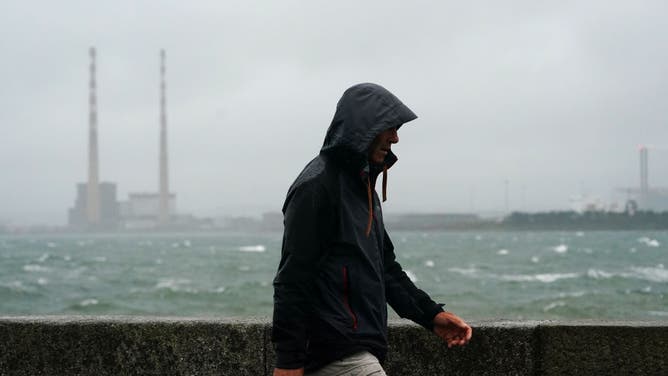
A man walks along Bull Wall, Dublin braving Storm Agnes.
(Brian Lawless/PA Images / Getty Images)
Battering winds and surf
Agnes' winds were seen pushing around a couple's truck home, a truck converted to living space with cab and motor intact, in a video shared by the owner of the vehicle. It is attached to the top of this story.
"It’s the view of the storm at Reenroe Beach just off the Ring of Kerry as seen from our 7.5-ton truck home," the owner told Storyful. "We set off in April and haven’t encountered winds like this since we were on the west coast of Scotland."
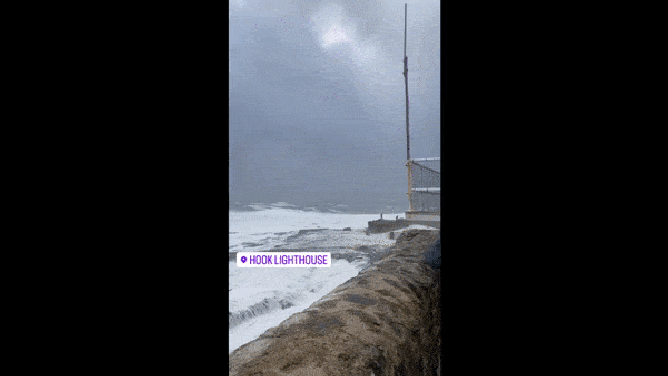
High surf hammers the coast at County Wexford, Ireland.
( Credit: Dillons Londis Fethard-On-Sea via Storyful / FOX Weather)
The couple initially parked on the beach but heeded the Met Office warnings.
"It’s a good job that we moved the truck!" the couple wrote on Facebook. "I just walked down to the seafront to check out the massive waves and where we were parked last night is now covered in huge rocks!"
They wrote that the storm arrived earlier than they expected, so they had no choice but to hunker down instead of fleeing as planned.
Another man traveled to the Bellewstown Races, a horse track in Ireland. He posted pictures of fans covered head to toe in foul-weather gear.
Storm Agnes making horse racing at Bellewstown, Ireland miserable
Joe Seward sat in his dry car and took video of the miserable conditions brought by Storm Agnes. "To say conditions are not ideal is a slight understatement," he posted on X.
"To say the conditions are not ideal is a slight understatement," he wrote.
Races started in the rain, but organizers said the track quickly deteriorated.
"It is now unfit for racing," stated an official in a post on X, formerly Twitter, while announcing the scratching of the last two races.
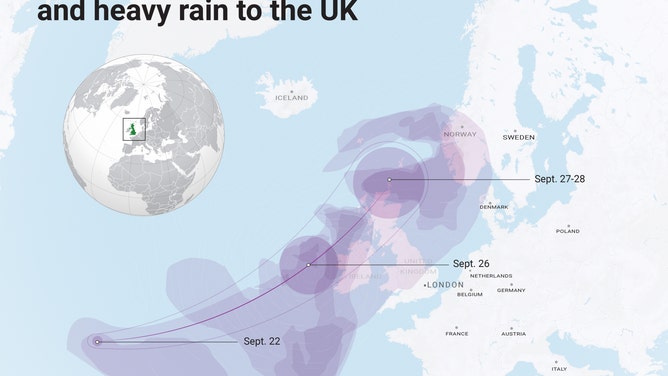
ANKARA, TURKIYE - SEPTEMBER 26: An infographic titled "Storm Agnes set to bring strong winds and heavy rain to the UK" created in Ankara, Turkiye on September 26, 2023. (Photo by Omar Zaghloul/Anadolu Agency via Getty Images)
( Omar Zaghloul/Anadolu Agency / Getty Images)
UK Met Office meteorologists point to Tropical Storm Ophelia as the culprit for spinning up Agnes.
"It's actually from Tropical Storm Ophelia that we've got Storm Agnes. It's not technically the remnants of Tropical Storm Ophelia. It's actually a separate low that's formed of the warmth from Tropical Storm Ophelia," said meteorologist Alex Berkel on the office's stream.
"What's happened is on the eastern flank of Ophelia, we've had some warm air pushing its way northward," he said. "That's then tightened the gradient and strengthened the jet stream, and that's all pushed a separate low-pressure system across the Atlantic."
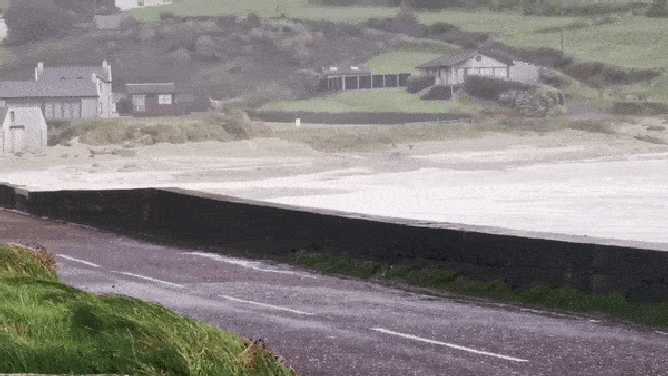
Waves crashing over a seawall and onto a road at Red Strand in west County Cork, near the towns of Ardfield, Castlefreke, and Rosscarbery.
(Credit: Kieran Fitzpatrick via Storyful / FOX Weather)
Why does Europe name storms?
The UK Met Office, Met Eireann (Ireland) and the Royal Netherlands Meteorological Institute released their annual list of storm names for the Western European countries in September.
"In the UK, a storm will be named when it has the potential to cause disruption or damage, which could result in an amber or red warning," wrote the UK Met Office. "This is based on our National Severe Weather Warnings service, which is a combination of both the impact the weather may have and the likelihood of those impacts occurring."
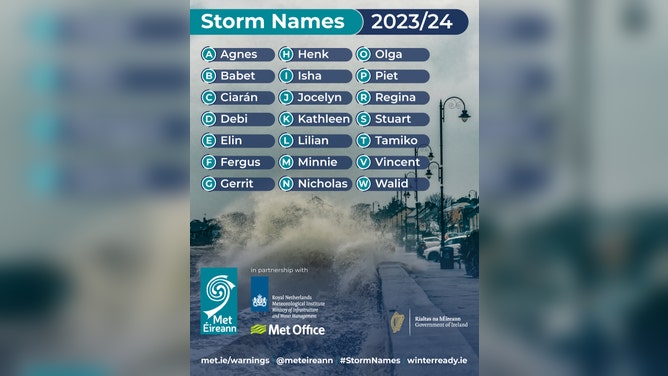
The 2023/24 windstorm names.
(Met Eireann / FOX Weather)
The agencies take name suggestions from employees and the public. Many of this year's names come from experts who work to protect people from extreme weather and famous scientists, the office told EuroNews.
For example, Ciaran is in honor of Ciaran Fearon, a Northern Ireland Department of Infrastructure worker. Agnes is a nod to Agnes Mary Clerke, an Irish astronomer and science writer who died in 1907.
Only two storms, Antoni and Betty were named in the 2022-23 season.
Other countries' agencies come up with their own windstorm names based on the region in which the country is located.
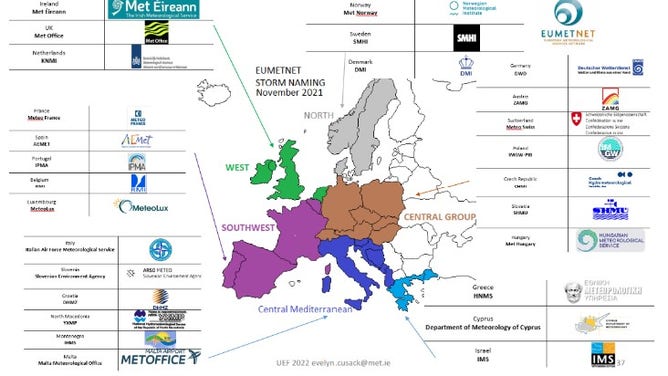
Other European countries that name storms.
(Met Eireann / FOX Weather)


